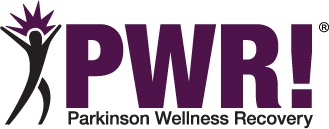Walk This Way! Enhancing Gait in PD w/Attentional Strategies | By Katelin Wisenor & Jenn Bazan-Wigle
“Bigger steps!” “Walk heel to toe!” “You’re not swinging your arms!” All these are commonly heard and said here at the PWR!Gym. But are these instructions helping? Let’s see what the experts say!
As PD-specific specialists, we’re constantly seeking innovative ways to support our clients with Parkinson disease (PD). Gait impairments are one of the hallmarks of PD and can be classified as either episodic (freezing of gait (FOG), festination), or continuous gait disturbances (shuffling, decreased arm swing, etc.). Because of its frequent interference in our clients’ daily lives, it is vital to find ways to help provide the most optimal feedback and environment for them to succeed. We know that to our clients, these aren’t just clinical symptoms but barriers to their independence, confidence, and overall quality of life. Thankfully for PWR!, we all know the magic of external cues! But what do we do if our “go-tos” don’t work? What else is out there?
A recent research article written in 2023 by Anouk Tosserams MD, Bastiaan R. Bloem MD, PhD, and Jorik Nonnekes MD, PhD entitled “Compensation Strategies for Gait Impairments in Parkinson’s Disease: From Underlying Mechanisms to Daily Clinical Practice” helps to sift through various forms of compensation; or in other words, attentional strategies that we can use with our clients with PD.
The Strategy Spectrum + Video Examples
- External Cueing One | Two | Three: Introducing an outside movement reference or stimulus. This can take countless forms including visual, tactile, imagery-based, and auditory.
- Internal Cueing: A stimulus or attention generated by the client typically seen through step counting, humming, and singing out loud in their head to find their rhythm. Personal “Reset Buttons” can be utilized with clients with FOG such as intentional postural adjustments to facilitate step initiation.
- Changing the Balance Requirements: Utilizing walking aids (trekking poles, walkers, etc.) or finding ways to facilitate lateral weight shifting to ease the initiation of walking.
- Altering the Mental State (no video): Introducing forms of mindfulness or motivation through breath work, meditation apps, and more to assist clients in either low or high-arousal states.
- Motor Imagery and Observation One | Two: Watching or visualizing a specific task before attempting the task. This stimulates our mirror neuron system which can help facilitate cortically generated movement for improved quality of gait disturbances.
- New Walking Patterns: Walking tasks such as walking big and fast, exaggerated arm swings or marches, or walking as if you were ice skating can be ways to introduce some novelty and goal-directed movement patterns.
- Alternative Mobility: In some scenarios, the best step may not be a step at all. Sometimes crawling, scooting, or dancing can offer a new alternative for our patients.
Tailoring the Approach
Remember, it’s not one-size-fits-all. Each client might respond differently to these strategies. Our job is to be the detective – finding clues in each individual’s response and crafting a personalized plan that is salient to them.
So What’s Next?
Research is still attempting to parse out the reasons why some individuals respond to various attentional cues and some don’t. In the meantime, challenge yourself to consider the following ways we can serve our clients to the best of our ability:
- Empowerment: Encourage clients to be active participants in choosing and refining their strategies.
- Education: Use layman’s terms to explain the ‘why’ behind each strategy – it’s about building understanding, not just compliance.
- Creativity: Each session is an opportunity to experiment and discover what works and what doesn’t. Let’s channel our inner creativity using these strategies to inspire theirs!
The PWR! Professional Perspective
We’re not just treating symptoms; we’re nurturing independence. These strategies aren’t just about treating or addressing clinical outcomes; they’re about walking alongside our clients in their journey with PD to help them achieve their most optimal quality of life and continue doing the things they love!
Resources
- Interactive website created by the article researchers with additional explanations and video examples
- Chart outlining the various classifications of attentional strategies with practical clinical examples (PDF)
- Original Research Citation: Nonnekes J, Ružicka E, Nieuwboer A, Hallett M, Fasano A, Bloem BR. Compensation Strategies for Gait Impairments in Parkinson Disease: A Review. JAMA Neurol. 2019;76(6):718-725. doi:10.1001/jamaneurol.2019.0033
